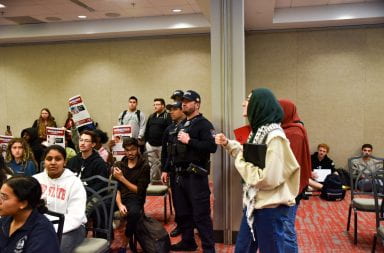
According to Ohio State’s enrollment report, 45 American Indian or Alaska Native students were enrolled at the university in Autumn 2022. Credit: Zachary Rilley | Photo Editor
Out of 62,523 students enrolled this spring, only 44 students at Ohio State identify as an American Indian or Alaska Native.
According to university reports, enrollment of Native American students at Ohio State is decreasing, and so are opportunities for student organizing and community building.
John N. Low, associate professor in the Comparative Studies Department at the Ohio State Newark campus and citizen of the Pokagon band of Potawatomi Indians, said the low number of Native Americans at the university is due to Indigenous tribes from Ohio being displaced to Canada, neighboring states or the West Coast.
Low said due to the tribes’ displacement, students from them have to pay out-of-state tuition, which is more expensive and impacts enrollment rates.
“Their ancestors didn’t have anything to do with their being removed,” Low said. “They were forcibly removed. So, that’s one of the reasons why we have such a small population of Native students at the Ohio State University.”
The university’s Land Acknowledgement states Ohio State occupies “the ancestral and contemporary territory of the Shawnee, Potawatomi, Delaware, Miami, Peoria, Seneca, Wyandotte, Ojibwe and many other Indigenous peoples.” These lands were ceded from indigenous tribes in the 1795 Treaty of Greenville and the forced removal of tribes through the Indian Removal Act of 1830, the acknowledgment states.
Ohio State is a land-grant university, originating with the Morrill Act of 1862 which allowed states to sell land, and the proceeds would be used to support the creation of a university. However, most of the land the states would sell came from tribal nations, Low said in the second episode of The Lantern’s “Who Knew?” that dives into the origins of Ohio State’s land-grant mission — to teach agriculture, mechanical arts or engineering and military science. Ten other subjects were added in 1871, according to the university libraries’ website.
According to Ohio State’s enrollment report, 45 American Indian or Alaska Native students were enrolled at the university in Autumn 2022. In 2016, 97 American Indian or Alaska Native were enrolled.
Emily Plumage, a second-year medical student and president of the Association of Native American Medical Students, said because of the low number of Native American students, the process of starting and maintaining the organization has been difficult.
The organization started with five members and was successful in hosting events and maintaining its presence on campus. When three members graduated, Plumage said she and her secondary leader struggled to gain recognition by the medical college. There is a lack of support to revive the organization because of the difficulty finding and reaching out to other Native American students in the medical school, she said.
“If you don’t have the numbers, you can’t start an org. If you can’t start an org, you can’t start a website. People don’t know you exist,” Plumage said.
Elissa Washuta, the director of Ohio State’s American Indian Studies program and member of the Cowlitz Indian Tribe said her experiences at the University of Washington showed her how connecting with other Natives can have a great impact.
“It was incredibly powerful for me to have those Native scholars as role models, even though we were in different subject areas,” Washuta said. “That really influenced who I am as a scholar and the way I approach research and teaching.”
Washuta said there is a cluster hire initiative in Indigenous Studies in the College of Arts and Sciences aiming to hire working in this area. This initiative is bringing Indigenous Studies faculty into the Department of Linguistics, Slavic and East European Languages and Cultures, Women’s Gender and Sexuality Studies and Comparative Studies.
The School of Environment and Natural Resources is searching for an assistant professor in Indigenous Environmental Studies, Washuta said. She said more Indigenous Studies faculty coming to the university in a variety of subjects is exciting to see.
“Not all Native studies faculty are Native and not all Native faculty teach Native studies,” Washuta said. “I think we have a lot of great opportunities in the coming years to continue doing this important work.”
Julius McIntyre, a third-year in sociology and the vice chair for the Justice and Equity Issue Committee of the Undergraduate Student Government, said the Native American and Indigenous Peoples Cohort at Ohio State sent a list of demands for action to USG’s Justice and Equity Committee and Diversity Committee, calling for more financial support for Native American students.
McIntrye said USG aims to work with James Orr, assistant vice provost of Strategic Enrollment and Management, to increase outreach to prospective Native American students.
Washuta said students can participate in events that celebrate Native American successes and culture. She said she remembers attending an alternative Thanksgiving in which students, both Native and non-Native, were present to celebrate with one another.
“The room was so packed, and the line was snaking around the room, and I loved seeing that. I loved seeing so many non-Native students showing up to show that there’s an interest in our presence and our experience,” Washuta said.
This story was updated at 9:40 p.m. Tuesday March 7 to clarify the hiring initiative in the College and Arts and Sciences is separate from the RAISE initiative and again at 12:38 p.m. Thursday March 9 to clarify the initiative aims to bring in Indigenous Studies Faculty, not just faculty of Native descent.


